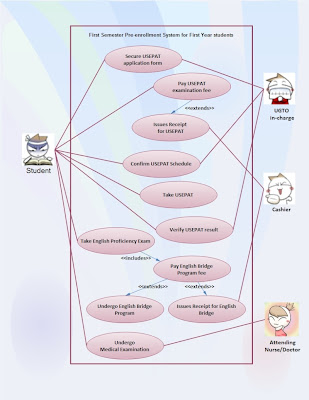The Life cycle and the University
Assignment # 5 - SAD 1
Consider your school, how do you know that the life cycle was developed specifically for the university. How do we know it meets our needs?
A “life cycle” can be defined differently in various fields of discipline but generally speaking, a life cycle is the complete process of change and development during somebody's lifetime or during the useful life of something such as an organization, institution, or manufactured product.
Since this subject is entitled Systems Analysis and Design, I will assume that the life cycle that we talk about here is the life cycle that a system undergoes while on development also known as the System Development Life Cycle (SDLC).
But before I convey my opinion whether the life cycle coincides with the university or not, I should first elaborate on the process of the development life cycle that a system undergoes.
According to teach-ict.com, here is the general system life cycle.
Based on the figure above, the following are the phases that a system should undergo during development:

The initial phase of the IS life cycle is the Feasibility study.
Generally, this is the phase where we define the problem and establish a high-level view of the intended project and determines its goals and objectives.
Specifically, we should be able to define the necessary feasibility studies such as the technical, economic, legal, operational, and schedule feasibility in order to assess the achievability of the project.
The next phase is what we call as the Requirement Analysis phase.
This is the stage where we literally analyze the requirements needed by the users for the system. Generally, this is the phase where we refine the project goals into defined functions and operation of the intended application. The gathering of data for this stage can be performed in many ways. One method is by interviewing the staff from different levels – from end users to senior management. Another method that can be used in this phase is examining the current business and systems documents and output. The documents and outputs may include current order documents, computer systems procedures and reports used by operations and senior management. Observation of current procedures can be also done as a method in generating requirements for the system because through observation, bottlenecks of the system can be detected.
After the Requirements Analysis is done, the System Design phase is next.
This is the phase where we describe the desired features and operations in detail, including screen layouts, business rules, process diagrams, and other documentation.
The details needed for this phase can include the hardware platform, software, outputs, user interface, modular design, test plan, conversion plan or the documentation.
Next is the Programming phase. This is where the actual system code is written.
After the Programming phase is done, we now proceed to the Integration and Testing:
This is the stage where we bring the various modules together into a testing environment to check for functionality, errors, bugs, and interoperability.
After Integration and testing, we now proceed to the Implementation phase. This is where the software is put into production and executes actual business processes. The actual installation of the hardware and software; training of personnel; and conversion of master files to new system are some of the processes done in this phase.
When the initial system development is done, Maintenance is next. This is where changes, correction, additions are done if there are still errors undetected during the whole process of development.
How do you know that the life cycle was developed specifically for the university?
If you would ask me if the life cycle that I showed above is specifically for the university, I can say that it is. Why? Because every system developed for the university should generally undergo feasibility study; requirements analysis; system design; programming; integration and testing; implementation and maintenance and then back to feasibility study if ever a new problem in the system comes up.
Does the general SDLC meet our needs for the university?
Yes. Why do I say so?
It is because every system in the university should undergo the phases that I mentioned one way or another. Every system should undergo those phases at some point in time during development in order to proceed with the proper and organize way and to avoid project failure.
The type of system development model can be different among developers but all the phases that I mentioned are inherent in all models. Those phases may overlap or maybe repeated on some models but what’s important is that those phases exist and should be properly performed to ensure success.
References:
information_systems_lifecycle.ppt
www.teach-ict.com/as_a2/topics/system_life_cycle/information_systems_lifecycle.ppt

Comments